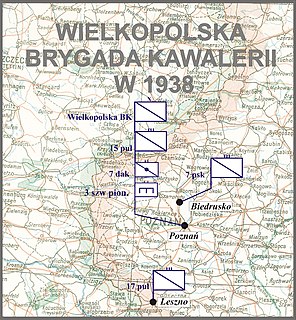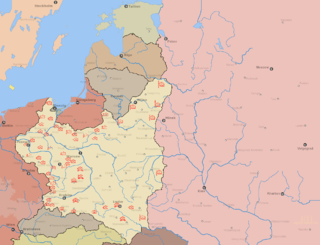
The Polish cavalry can trace its origins back to the days of medieval mounted knights. Poland is mostly a country of flatlands and fields and mounted forces operate well in this environment. The knights and heavy horse cavalry gradually evolved into many different types of specialised mounted military formations, some of which heavily influenced western warfare and military science. This article details the evolution of Polish cavalry tactics, traditions and arms from the times of mounted knights and heavy winged hussars, through the times of light uhlans to mounted infantry equipped with ranged and mêlée weapons.
The following is a standard order of battle of the Polish cavalry brigade in 1939.
Battle of Wólka Węglowa refers to the battle on September 19, 1939, that took place near Wólka Węglowa, during the last stages of the Polish counteroffensive of the Invasion of Poland.

Kresowa Cavalry Brigade was a unit of the Polish Army in the interbellum period. It was organized on April 1, 1937 and was based on the Second Cavalry Brigade. Stationed in the town of Brody, it consisted of several regiments:

Nowogródzka Cavalry Brigade was a cavalry unit of the Polish Army in the interbellum period. It was created on April 1, 1937, out of the Baranowicze Cavalry Brigade. Its headquarters were stationed in the town of Baranowicze. It consisted of several units, garrisoned in several towns located in northeast part of pre-1939 Poland:

Mazowiecka Cavalry Brigade was a cavalry unit of the Polish Army in the interbellum period, which took part in the Polish September Campaign. It was created on April 1, 1937, out of former 1st Cavalry Brigade. Its headquarters were in Warsaw, with other units stationed in towns around the capital:
Wilenska Cavalry Brigade was a unit of the Polish Army, created on 1 April 1937 out of the 3rd Independent Cavalry Brigade. Its headquarters were stationed in Wilno, with some regiments garrisoned in the neighboring towns. In late 1930s it consisted of these units:
Władysław Mackiewicz was a Polish Cavalry Captain (rotmistrz) in the 15th Uhlan Regiment and a recipient of the Virtuti Militari, Poland's highest decoration.

15th Poznań Uhlans Regiment – unit of Polish cavalry, part of Greater Polands Army, Polish Army of Second Republic and Polish Armed Forces in the West during World War II.

The First Krechowce Uhlan Regiment was a mounted unit of the Polish Army, active in the Second Polish Republic. Its traditions were continued during World War II, by a regiment of the same name, which was part of Polish Armed Forces in the West. 1st Krechowce Uhlan Regiment was formed in 1915, as a unit of the Imperial Russian Army. It fought in World War I, Polish–Soviet War and the Invasion of Poland, as part of Suwalska Cavalry Brigade. Until 1939, the regiment was stationed in Augustów. It ceased to exist in 1947. First commandant of the regiment was a Tsarist officer of Polish ethnicity, Colonel Bolesław Mościcki, who was killed in 1918 near Łuniniec. Last commandant was Colonel Leon Strzelecki.

The 2nd Grochow Uhlan Regiment of General Jozef Dwernicki was a cavalry regiment of Polish I Corps in Russia, Polish Army in the Second Polish Republic, and the Home Army during Operation Tempest (1944). The regiment was formed in November 1917 in Volhynia, and in 1921–1939, it was garrisoned in Suwałki, in the barracks of former Imperial Russian Army's 2nd Pskov Dragoons Regiment. In the 1939 Invasion of Poland it was part of Suwalska Cavalry Brigade.

17th Greater Poland Uhlan Regiment of King Boleslaw Chrobry was a cavalry unit of the Polish Army in the Second Polish Republic. Formed in 1919, it was garrisoned in Leszno. The regiment, whose patron was King Boleslaw Chrobry, fought in the Polish–Soviet War and the 1939 Invasion of Poland, as part of Wielkopolska Cavalry Brigade.
24th Uhlan Regiment of Crown Hetman Stanislaw Zolkiewski was a cavalry unit of the Polish Army in the Second Polish Republic. Formed in June 1920, it fought both in the Polish–Soviet War and the 1939 Invasion of Poland. The regiment was garrisoned in the town of Kraśnik, and belonged to the elite 10th Motorized Cavalry Brigade.

















